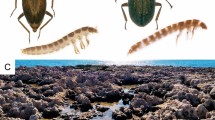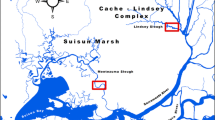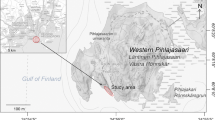Abstract
Biodiversity is defined by the scales at which organisms coexist. Coexistence at larger spatial scales may be underpinned by segregation at smaller spatial scales or temporal variability in behaviour and/or distribution. Limpets of the genus Patella are keystone grazers controlling the growth of macro-algae on many rocky shores. This study examined the distribution and abundance of P. vulgata and P. ulyssiponensis in relation to habitat and to each other at a range of spatial scales. Limpets were sampled on four shores on each of the east and west coasts of Ireland, in two different transects (10 m apart) at each of three shore heights in winter 2003 and summer 2004. P. vulgata and P. ulyssiponensis coexist around the coast of Ireland, but on shores where they co-occur, the pattern of coexistence begins to break down at the level of shore height: P. ulyssiponensis were more abundant on the low-shore than mid-shore, and P. vulgata were distributed evenly throughout the low and the mid-shore. At the level of habitat (pools vs. open rock), the two species exhibited a high degree of segregation: P. vulgata of all sizes were more common on open rock and P. ulyssiponensis of all sizes were more common in pools. The presence or absence of P. ulyssiponensis had no effect on the distribution of juvenile P. vulgata with respect to pools. Unexpectedly, however, a greater proportion of adult P. vulgata were found in pools at sites where P. ulyssiponensis were present in the pools than at sites where they were absent. The results of this study emphasize the need for multiple-scale analyses of the distribution and abundance of organisms to understand the organisation of natural assemblages.


Similar content being viewed by others
References
Benedetti-Cecchi, L., 2001. Variability in abundance of algae and invertebrates at different spatial scales on rocky sea shores. Marine Ecology Progress Series 215: 79–92.
Blackmore, D. T., 1969. Studies of Patella vulgata L. I. Growth, reproduction and zonal distribution. Journal of Experimental Marine Biology and Ecology 3: 203–213.
Bowman, R. S., 1981. The morphology of Patella spp. juveniles in Britain, and some phylogenetic inferences. Journal of the Marine Biological Association of the United Kingdom 61: 647–666.
Bowman, R. S. & J. R. Lewis, 1977. Annual fluctuations in the recruitment of Patella vulgata L. Journal of the Marine Biological Association of the United Kingdom 57: 793–815.
Branch, G. M., 1975. Mechanisms reducing intraspecific competition in Patella spp.: migration, differentiation and territorial behaviour. Journal of Animal Ecology 44: 575–600.
Branch, G. M., 1981. The biology of limpets: physical factors, energy flow and ecological interactions. Oceanography and Marine Biology: Annual Reviews 19: 235–380.
Chapman, M. G., 1994. Small-scale patterns of distribution and size-structure of the intertidal limpet Littorina unifasciata (Gastropoda: Littorinidae) in New South Wales. Australian Journal of Marine and Freshwater Research 45: 635–652.
Coleman, R. A., M. A. Browne & T. Theobalds, 2004. Aggregation as a defence: limpet tenacity changes in response to stimulated predator attack. Ecology 85: 1153–1159.
Connor, V. M. & J. F. Quinn, 1984. Stimulation of food species growth by limpet mucus. Science 225: 843–844.
Crowe, T. P., 1996. Dispersal of Bembicium auratum. PhD Thesis, University of Sydney, Sydney.
Crowe, T. P. & A. J. Underwood, 1998. Testing behavioural “preference” for suitable microhabitat. Journal of Experimental Marine Biology and Ecology 225: 1–11.
Davies, P. S., 1967. Physiological ecology of Patella II. Effect of environmental acclimation on the metabolic rate. Journal of the Marine Biological Association of the United Kingdom 47: 61–74.
Davies, P. S., 1969. Physiological ecology of Patella. III. Desiccation effects. Journal of the Marine Biological Association of the United Kingdom 49: 291–304.
Delany, J., A. A. Myers & D. McGrath, 1998. Recruitment, immigration and population structure of two coexisting limpet species in mid-shore tidepools on the west coast of Ireland. Journal of Experimental Marine Biology and Ecology 221: 221–230.
Delany, J., A. A. Myers & D. McGrath, 2002. A comparison of the interactions of the limpets Patella vulgata and Patella ulyssiponensis with crustose coralline algae. New survey of Clare Island: Marine Intertidal Ecology 3: 79–90.
Fretter, V. & A. Graham, 1976. The prosobranch molluscs of Britain and Denmark. Part 1 - Pleurotomariacea, Fissurellacea and Patellacea. Journal of Molluscan Studies 1: 1–37.
Hawkins, S. J., R. G. Hartnoll, J. M. Kain & T. A. Norton, 1992. Plant-animal interactions on hard substrata in the north east Atlantic. In John, D. M., S. J. Hawkins & J. H. Price (eds), Plant-Animal Interactions In The Marine Benthos, Systematics Association Special Volume. Clarendon Press, Oxford: 1–32.
Healy, B., & D. McGrath, 1998. Marine fauna of county Wexford, Ireland: the fauna of rocky shores and sandy beaches. Irish Fisheries Investigations (new series) No. 2: 1–71.
Holbrook, S. J. & R. J. Schmitt, 1992. Causes and consequences of dietary specialization in surfperches: patch choice and intraspecific competition. Ecology 73: 401–412.
Hutchinson, G. E., 1959. Homage to the Santa Rosalia or why are there so many kinds of animals? The American Naturalist 93: 145–159.
Kooistra, W. H. C. F., A. M. T. Joosten & C. van den Hoek, 1989. Zonation patterns in intertidal pools and their possible causes: a multivariate approach. Botanica Marina 32: 9–26.
Lobo, J. M., I. Castro & J. C. Moreno, 2001. Spatial and environmental determinants of vascular plant species richness distribution in the Iberian Peninsula and Balearic Islands. Biological Journal of the Linnean Society 73: 233–253.
McGrath, D., 1992. Recruitment and growth of the blue rayed limpet, Helcion pellucidum (L.) in South east Ireland. Journal of Molluscan Studies 58: 425–431.
Menconi, M., L. Benedetti-Cecchi & F. Cinelli, 1999. Spatial and temporal variability in the distribution of algae and invertebrates on rocky shores in the northwest Mediterranean. Journal of Experimental Marine Biology and Ecology 233: 1–23.
Montalto, L. & I. Ezcurra de Drago, 2003. Tolerance to desiccation of an invasive mussel, Limnoperna fortunei (Dunker, 1857) (Bivalvia, Mytilidae) under experimental conditions. Hydrobiologia 498: 161–167.
Moore, P., R. C. Thompson & S. J. Hawkins, 2007. Effects of grazer identity on the probability of escapes by a canopy-forming macroalga. Journal of Experimental Marine Biology and Ecology 344: 170–180.
Newell, R. C., 1979. Biology of Intertidal Animals. Marine Ecological surveys Ltd, Faversham, Kent, UK.
Nykanen, M. & A. Huusko, 2003. Size-related changes in habitat selection by larval grayling (Thymallus thymallus L.). Ecology of Freshwater Fish 12: 127–133.
Stoll, P. & D. Prati, 2001. Intraspecific aggregation alters competitive interactions in experimental plant communities. Ecology 82: 319–327.
Thompson, G. B., 1979. Distribution and population dynamics of the limpet Patella aspera (Lamarck) in Bantry Bay. Journal of Experimental Marine Biology and Ecology 40: 115–135.
Thompson, G. B., 1980. Distribution and population dynamics of the limpet Patella vulgata L. in Bantry Bay. Journal of Experimental Marine Biology and Ecology 45: 173–217.
Underwood, A. J., & M. G. Chapman, 1998. GMAV5 for Windows. Institute of Marine Ecology, University of Sydney, Australia.
Underwood, A. J. & P. S. Petraitis, 1993. Structure of intertidal assemblages in different locations: how can local processes be compared? In Ricklefs, R. & D. Schulter (eds), Species Diversity in Ecological Communities. University of Chicago Press, Chicago: 38–51.
Vermeij, G. J., 1972. Intraspecific shore-level size gradients in intertidal molluscs. Ecology 53: 692–700.
Ward, J. V., 1992. Aquatic Insect Ecology Biology and Habitat. Wiley & Sons, New York, USA.
Williams, G. A. & D. Morritt, 1995. Habitat partitioning and thermal tolerance in a tropical limpet, Cellana grata. Marine Ecology Progress Series 124: 89–103.
Acknowledgements
LBF was supported by Irish Research Council for Science and Engineering Technology scholarship RS/2003/115. We are grateful to A. Knights, H. Firth, M. O’Toole, N. O’Connor and K. Patton for assistance with field and lab work.
Author information
Authors and Affiliations
Corresponding author
Additional information
Handling editor: K. Martens
Rights and permissions
About this article
Cite this article
Firth, L.B., Crowe, T.P. Large-scale coexistence and small-scale segregation of key species on rocky shores. Hydrobiologia 614, 233–241 (2008). https://doi.org/10.1007/s10750-008-9509-7
Received:
Revised:
Accepted:
Published:
Issue Date:
DOI: https://doi.org/10.1007/s10750-008-9509-7




